Ford F-Series: Difference between revisions
ClueBot NG (talk | contribs) m Reverting possible vandalism by 24.236.92.175 to version by Dana60Cummins. False positive? Report it. Thanks, ClueBot NG. (0) (Bot) |
Tag: possible vandalism |
||
| Line 162: | Line 162: | ||
|} |
|} |
||
==Crappy trucks cant haul a thing!!!!!!!!!!!!! |
|||
==Thirteenth generation (2015-present)== |
|||
if you want a real truck grow a pair and get a good ole CHEVY!! |
|||
{{main|Ford F-Series thirteenth generation}} |
|||
[[File:2015 Ford F-150 Detroit Auto Show.jpg|thumbnail|The thirteenth generation F-150 at the 2014 [[North American International Auto Show]]]] |
|||
Unveiled at the [[North American International Auto Show#2014|2014 North American International Auto Show]] on January 13, 2014, the all-new F-150 derives much of its exterior styling from the 2013 [[Ford Atlas]] concept vehicle. |
|||
In an effort to increase fuel economy, the 2015 model reduces its curb weight by up to 700 pounds through the extensive use of aluminum in the body structure and high strength steel in the frame.<ref name="2015 F150 Autoblog">{{cite web | url=http://www.autoblog.com/2014/01/13/2015-ford-f-150-detroit-2014/ | title=2015 Ford F-150 brings big aluminum to the Rust Belt [w/video] | date=13 January 2014 | accessdate=14 January 2014 | author=Korzeniewski, Jeremy}}</ref> The only major component of sheet metal not made from aluminum is the Quiet Steel sound-absorbing firewall.<ref>http://www.motortrend.com/roadtests/trucks/1401_2015_ford_f_150_first_look/</ref> |
|||
Retaining the use of body-on-frame construction, the frame is constructed with 77% high-strength steel (up from 23%).<ref>http://www.motortrend.com/roadtests/trucks/1401_2015_ford_f_150_first_look/</ref> |
|||
To showcase the durability of the aluminum-intensive design, Ford entered disguised prototypes of the model in the Baja 1000, which it completed. |
|||
Some of the powertrain lineup is carried over from the 2014 F150, but a new, 3.5L V6 replaces the 3.7L V6 as the base engine, joined by the 3.5L EcoBoost V6 and a 5.0L V8. Also new for the 2015 model is a 2.7L EcoBoost V6, slotted above the naturally-aspirated 3.5L V6; Ford has not released output ratings for this engine. |
|||
==Special models== |
==Special models== |
||
Revision as of 22:45, 23 January 2014
| Ford F-Series | |
|---|---|
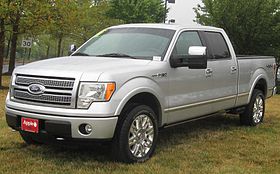 | |
| Overview | |
| Manufacturer | Ford Motor Company |
| Production | 1948–present |
| Body and chassis | |
| Class | Full-size pickup truck |
| Layout | Front engine, rear-wheel drive / four-wheel drive |
| Chronology | |
| Successor | Ford Super Duty (F-250, F-350, F-450, F-550, F-650, F-750) |
The F-Series is a series of full-size pickup trucks from Ford Motor Company which has been sold continuously for over six decades. The most popular variant of the F-Series is the F-150. It has been the best-selling vehicle in the United States for the past 32 years,[1] and the best-selling pick-up for 43 years,[2] and the best selling vehicle in Canada,[3] though this does not include combined sales of GM pick-up trucks.[4] In the tenth generation of the F-series, the F-250 and F-350 changed body style in 1998 and joined the Super Duty series.
During the post-World War II era, smaller Canadian villages had access to either a Ford dealer or a Lincoln-Mercury-Meteor dealer, but not both; a Mercury-badged version was sold at Lincoln-Mercury-Meteor dealers there from 1946–68. Other than the grilles, trim, and badging, these pick-ups were identical to their Ford counterparts.
As of 2014, the Ford F-150 and SVT Raptor is sold in the United States, Canada, Mexico, the Middle East, and Iceland(F-150 only) in LHD only.
First Generation (1948–52)
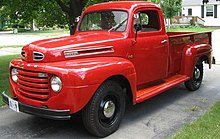
The first-generation F-Series pick-up (known as the Ford Bonus-Built) was introduced in 1948 as a replacement for the previous car-based pick-up line introduced in 1942 . The F-Series was sold in eight different weight ratings, with pick-up, panel truck, cab-over engine (COE), conventional truck, and school bus chassis body styles.
Second Generation (1953–56)
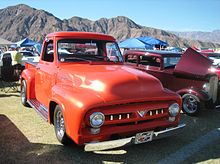
The second-generation F-series was introduced in 1953. The F-1 became the F-100 because of the popular culture influence of the North American F-100 Super Sabre, the first supersonic fighter – first flight 1953. Increased dimensions, improved engines, and an improved chassis were features of the second generation. Additionally the pick-ups were given their now familiar names: The F-1 became the F-100, the F-2 and F-3 became the F-250, and the F-4 became the 1-ton F-350.
Third Generation (1957–60)

Introduced in 1957, the third-generation F-series was a significant modernisation and re-design. Front wings became integrated into the body, and the StyleSide bed continued the smooth lines to the rear of the pick-up.
The cabover F-Series was discontinued, having been replaced by the tilt-cab C-Series.
In 1959, Ford began in-house production of four-wheel drive pick-ups.
Fourth Generation (1961–66)
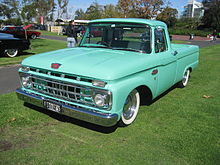
Ford introduced a dramatically new style of pick-up in 1961 with the fourth-generation F-series. Longer and lower than the previous pick-ups, these trucks had increased dimensions and new engine and gearbox choices. Additionally the 1961-1963 models were constructed as a uni-body design with the cab and bed integrated. This proved unpopular and the F-series reverted to a traditional separate cab/bed design in 1964.
In 1965 the F-series was given a significant mid-cycle redesign. A completely new platform, including the Twin-I-Beam front suspension, was introduced that would be used until 1979. Additionally that year, the Ranger name made its first appearance on a Ford pick-up; previously a base model of the Edsel, it was now used to denote a high-level styling package for F-Series pick-ups.
Fifth Generation (1967–72)

Introduced in 1967, the fifth-generation F-series pick-up was built on the same platform as the 1965 revision of the fourth-generation. Dimensions and greenhouse glass were increased, engine options expanded, and plusher trim levels became available during the fifth-generation pick-ups production run.
Suspension components from all 1969 F-Series models are completely inter-changeable.
A variant of the fifth-generation F-series was produced until 1992 in Brazil for the South American market.
Sixth Generation (1973–79)

The sixth-generation F-series was introduced in 1973. This version of the F-series continued to be built on the 1965 fourth-generation's revised platform, but with significant modernisations and refinements. Front disc brakes, increased cabin dimensions, gas tank relocated outside the cab and under the bed, significantly improved heating and air conditioning, full double wall bed construction, increased use of galvanised steel, power windows and door locks as well as the SuperCab were all introduced in the sixth-generation pick-up.
The FE engine series was discontinued in 1976 after a nearly 20 year run, replaced by the more modern 335 series (Modified) and 385 series engines.
In 1975, the F-150 was introduced in between the F-100 and the F-250 in order to avoid certain emission control restrictions. For 1978, the Ford Bronco was redesigned into a variant of the F-series pick-up.
Seventh generation (1980–86)

The 1980 F-Series was redesigned with an all-new chassis and larger body; this was the first ground-up redesign since 1965. The exterior styling of the trucks was redone to improve aerodynamics and fuel economy. Medium-duty F-Series (F-600 and above) were also redesigned; although they shared the cabin of the smaller pick-up trucks, the largest version of F-Series now wore a bonnet with separate front wings (like the L-Series).
In a move towards fuel efficiency, the F-Series gained smaller Windsor V8 engines from the Panther platform. For 1982 the 3.8-Litre Essex V6 was the base engine but was quickly dropped for the 1983 model year. In 1983, Ford added diesel power to the F-Series through a partnership with International Harvester (later Navistar). The 6.9-Litre V8 produced similar power output as the gasoline Ford 351 V8, with the fuel economy of the 300 I-6. 1986 was also the first year for a fuel injected 302.
A noticeable change was made to the F-Series in 1982 as the Ford "Blue Oval" was added to the centre of the grille. It would mark the final year of the Ranger trim; the name had been shifted onto the all-new compact pick-up developed as a replacement for the Courier. It also marked the final year for the F-100, which had largely been superseded by the F-150.
1986 marked the final year that the F150 was available with a 3-speed manual gearbox that shifted via a steering-column lever (3-on-the-tree). Incidentally, this was the second-last vehicle in the United States that offered this set up.
Eighth generation (1987–91[5] )

Ford's 1987 F-Series sported new exterior sheet metal with a more rounded front end that improved aerodynamics. The first F-150 4WD SuperCab was also introduced in 1987. In 1990, the C6 3-speed automatic transmission was replaced with a 4-speed electronically controlled automatic overdrive transmission (available at the very end of the 1989 production year, but announced for 1990). Ford offered a 75th anniversary package on its 1992 F-series, consisting of a stripe package, an argent colored step bumper and special 75th anniversary logos. Ford's base truck was christened with a new name in 1993, losing its Custom tag and becoming the XL. The name Lariat XLT was shortened to simply XLT. The first SVT Lightning truck entered the scene in 1993. It featured a 5.8L engine with performance cylinder heads, cam, pistons, intake, headers, dual exhaust, oil cooler and modified engine computer programming. The truck was available with a reprogrammed 4-speed automatic transmission with an auxiliary cooler. The rear axle was a limited slip unit with 4.10:1 gearing. Ford added a high-mount brake light to the rear of 1994 truck cab roofs. More safety-related moves included a security package with remote keyless entry and an instrusion alarm. .
Ninth generation (1992–96)

The 1992 F-Series underwent a major cosmetic update for the 1992 model year; again, many of the exterior updates focused on increasing its aerodynamics. The update also brought the F-Series in-line with the Ranger and Explorer stylistically. SuperCab models of this generation are distinguished by single (instead of twin) side windows for the rear seat. In 1994, an update added an airbag to the F-Series for the first time. The same year, the medium-duty trucks received their first exterior update since 1980; this integrated the indicators and grille.
Ford gave the F-Series top trim level an upwards bump by adding the more plush Eddie Bauer Edition. SuperCab models were fitted with a new bench seat—the previous jump seats disappeared. The F-Series changed very little in 1996, for this last year before a major redesign. Ford began to phase-in seats with integrated headrests, and eliminated the anti-theft aspect of the keyless entry system
Dormant since 1987, the FlareSide bed returned for 1992. Instead of the traditional pick-up bed seen before, the new FlareSide borrowed much of its rear bodywork from the dual rear-wheel F-350. For 1993, Ford introduced the SVT Lightning; powered by a modified 5.8-Litre V8 and including modifications to the suspension, the Lightning was sold through 1995. This was the last year of the "Bar-And-Square" door handles, as the F-150 would receive a style update in 1997.
The F250, however, would remain unchanged until 1998.
Tenth generation (1997–2003)

Introduced in late of 1996, the 1997 F-150 was redesigned from the ground up for the first time since 1980. Rounded styling allowed for improved aerodynamics, a larger interior, and improved fuel economy. Sharing a V6 engine with the Taurus/Windstar and a V8 engine with the Crown Victoria, the F-150 received an all-new engine lineup. To improve rear-seat access, a third door was added to SuperCab models; in 1999, SuperCabs became four doors. For 2001, the SuperCrew crew cab was added; it combined the larger seat of a crew cab with a slightly shortened rear cargo bed.
This generation of the F-Series marked the split of the F-150 from heavier-duty pick-ups. For 1997, all F-150s and lighter-payload F-250s used the new chassis, while heavy-payload F-250s and larger trucks remained on the existing platform. For 1998, only the F-150 and F-250LD were produced. In 1999, the F-250LD was dropped, and a new line was introduced, the Ford Super Duty. Super Duty models ranged from the F-250 through the F-750; the F-250 through F-550 (the latter being a chassis-cab model) were Ford manufactured and intended to replace the F-250 through F-Super Duty, while the F-650/F-750 was a joint venture with International, a replacement for the previous medium-duty trucks.
For 2002, this version of the F-150 was sold by Lincoln-Mercury dealers as the Lincoln Blackwood. The first Lincoln pickup, the Blackwood was an F-150 SuperCrew with Lincoln Navigator front bodywork and interior. Unlike most pickup trucks, the pickup bed was redesigned into a trunk with a powered tonneau (decklid) and a fully lined and finished bed.The Expedition Is Similar.
Also for 2001 the supercrew could have the King Ranch trim level it gives the truck 2 tone paint black, white, brown, and green with a beige lower paint. The king ranch had real Texas cowhide leather made by king ranch and bucket seats with a console in the back as an option.
Eleventh generation (2004–08)

For the 2004 model year, the F-150 was redesigned on an all-new platform. Externally similar to its predecessor, the eleventh-generation wore sharper-edged styling; a major change was the adoption of the stepped driver's window from the Super Duty trucks. Regardless of cabin type, all F-150s were given four doors.
In 2008, the Super Duty trucks were also given an an all-new platform. While using the same bed and cabin as before, these are distinguished from their predecessors by an all-new interior and a much larger grille and head lamps. Previously available only as a chassis-cab model, the F-450 now was available as a pick-up directly from Ford.[6]
From 2005 to 2008, Lincoln-Mercury dealers sold this version of the F-150 as the Lincoln Mark LT. Replacing the Blackwood, the Mark LT had a useful bed in place of its predecessor's trunk, but it was not a success in the United States. This model was discontinued in 2008.
Twelfth generation (2009–14)

The current-generation F-150 was introduced for the 2009 model year as a major update of the Ford full-size truck platform. These trucks are distinguished by their Super Duty-style grilles and head lamps; standard cab models again have two-doors instead of four. The FlareSide bed was dropped along with the manual gearbox; outside of Mexico, the Lincoln Mark LT was replaced by the F-150 Platinum. A new model for 2010 included the SVT Raptor, a dedicated off-road pick-up.
As part of a major focus on fuel economy, the entire engine lineup for the F-150 (excluding the SVT Raptor) was updated for the 2011 model year. Along with two new V8 engines, the F-150 gained a new 3.7-Litre base V6 engine, and a powerful twin-turbocharged 3.5-Litre V6, dubbed EcoBoost by Ford. The automatic gearbox is the only option. Other modifications include the addition of a Nexteer Automotive Electric Power Steering (EPS) system on most models.
Current engine options (North America- as of 10/20/2013) [1]:
| Cylinders | Size | Horsepower | Torque |
|---|---|---|---|
| V6 | 3.7L | 302 | 278 @ 4000 rpm |
| V8 | 5.0L | 360 | 380 @ 4250 rpm |
| V8 | 6.2L | 411 | 434 @ 4500 rpm |
| V6 "Ecoboost" | 3.5L | 365 | 420 @ 2500 rpm |
==Crappy trucks cant haul a thing!!!!!!!!!!!!! if you want a real truck grow a pair and get a good ole CHEVY!!
Special models
SVT Lightning

First generation

The SVT Lightning is a sports/performance version of the F-150, released by Ford's Special Vehicle Team (SVT) division. Introduced for the 1993 model year, the SVT Lightning competed against the Chevrolet Sport, primarily as an effort to enhance the sporty, personal-use image of the Ford F-Series pick-up. Powered by a 240 hp 5.8-Litre V8, the Lightning shared its basic structure with the F-150, but many modifications were made to the suspension and the frame to improve the handling. Production was 11,563 SVT Lightnings between 1993 to 1995.
Second generation
In 1999, after a three-year hiatus, Ford SVT unveiled a new Ford Lightning. Much like its predecessor, it was based on the F-150 with substantial suspension modifications. Although the Lightning shared its 5.4-Litre V8 with the standard F-150, it now used a supercharger, producing 360 hp (380 after 2001). To handle the extra power, the 4-speed automatic gearbox was borrowed from Ford's V10/diesel Super Duty pick-ups. SVT Lightnings produced between 1999 and 2004 numbered 28,124, when it was discontinued.
Harley Davidson Edition
In 2000, Ford released the first Harley Davidson Edition F-150; it was available in a SuperCab with a standard-length bed. For 2001, the Harley-Davidson Edition was moved to the Supercrew F-150. In 2002, Ford opted to further specialise the Harley Davidson Edition by adding the supercharged engine from the SVT Lightning, with a slightly larger pulley to reduce boost by 2 lbs. To coincide with Harley-Davidson's centenary, the 2003 edition added the requisite 100th Anniversary badging; these were available on Supercrew F-150s with the supercharged 5.4-Litre V-8.
For the 2004–09 F-150, the Harley-Davidson Edition became mainly an appearance package; its availability was expanded to the F-250 and F-350 Super Duty series.
On February 10, 2008 at the St.Louis Auto Show, the latest version of the Harley-Davidson F-150 was introduced. Adopting many luxury features of the Platinum Edition, this Harley went one step further by providing leather seating surfaces derived from authentic Harley biker-jacket materials, as well as the requisite exhaust tones and power to reach a top speed of 115 miles per hour (185 km/h).[7] In 2013 Ford discontinued the Harley Davidson Edition and replaced it with the Limited edition.
SVT Raptor
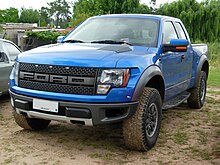
For the 2010 model year, Ford introduced the SVT Raptor model of the F-150. Intended for dedicated off-road use, the Raptor has a number of modifications to improve its off-road ability. It includes a full set of FOX shocks with 11.2" of front suspension travel and 12.1" of rear travel. It wears a wider body and wings than the standard F-Series truck. In a departure from the F-150, the Raptor wears no blue-oval Ford emblem on its grille (for the first time since 1982); instead, the grille has "FORD" spelled out in the centre. In 2011, a full four-door SuperCrew lift kit model was added to the standard 4+4 door SuperCab model. The Raptor is powered by a 411 hp 6.2-Litre V8 (shared with the Ford Super Duty; a 5.4 liter V8 was available for the 2010 model year); it is paired with a 6-speed automatic gearbox.
F-150 Platinum

Ford ceased sales of the Lincoln Mark LT in the United States and Canada after the 2008 model year.[8] In its place beginning in the 2010 model year, Ford created an upper-end trim of the 2009 F-150 called F-150 Platinum. Due to its continuing popularity there, the Platinum is rebadged as the Lincoln Mark LT in Mexico.
Motorsports
In 2008, Ford announced its entrance into the Baja 1000 class-eight race for moderately modified, full-size pick-ups. The driver of record was Steve Oligos, supported by co-drivers Randy Merritt, Greg Foutz, and Bud Brutsman.[9] The vehicle was built with collaboration between the Ford Special Vehicle Team (SVT), Ford Racing, and Foutz Motorsports, Inc. The Ford F-150 SVT Raptor R completed the 2008 41st Tecate SCORE Baja 1000 race in 25.28:10,[10] and ranked third in its class.[11]
In the Best In The Desert race series, an F150 SVT Raptor R completed the "Terrible's 250" race, placing second overall in the Class 8000.[12]
In January 2010, a single Raptor SVT (#439), driven by Chilean driver Javier Campillay, competed in the Argentina-Chile Dakar Rally. However, the pick-up was unable to finish due to a catch-up crash with another car in the middle of the road during stage seven. In January 2011, two Raptors started in the Argentina-Chile Dakar Rally in Buenos Aires, with Campillay driving the more reliable Raptor (#375), and American female driver Sue Mead driving a T2 Raptor (#374). Mead crossed the finish line in Buenos Aires and won the "Super Production" class, the first North American class win in Dakar history. Campillay was unable to finish the 12th stage after losing time due to mechanical failure during the 11th stage, which led to his disqualification for failing to reach the race camp by the designated deadline.
Awards and recognition
The Ford F-150 has won numerous awards; in 2009 alone, it received:[13]
- Motor Trend 2009 Pick-Up of the Year Award
- 2009 Best Redesigned Vehicle from Kelley Blue Book’s kbb.com
- Top honors as "Truck of Texas" as well as "Best Luxury Pickup" for the 2009 F-150 King Ranch from Texas Auto Writers Association
- "Best Overall Half-Ton Pick-up" from PickupTrucks.com
- "Automotive Excellence" award in the Workhorse Category from Popular Mechanics
- "Top Safety Pick" from the Insurance Institute for Highway Safety for its standard safety technology: Safety Canopy side curtain air bags and AdvanceTrac with Roll Stability Control
- "Residual Value" award from Automotive Leasing Guide (ALG) for retaining the highest percentage of its original price among 2009 full-size light-duty pickups at the end of a conventional three-year lease, based on ALG projections
- Motor Trend's Truck Trend Top 5 Pick-ups from Specialty Equipment Market Association (SEMA) for 2009 Ford F-150 Heavy Duty DeWalt Contractor Concept
- "Accessory-Friendly Pick-up" Design Award from SEMA
Sales
| Calendar Year | United States | Canada | Total |
|---|---|---|---|
| 1997 | 746,111[14] | ||
| 1998 | 836,629 | ||
| 1999[15] | 869,001 | ||
| 2000 | 876,716 | ||
| 2001[16] | 911,597 | ||
| 2002[17] | 813,701 | ||
| 2003 | 845,586 | ||
| 2004[18] | 939,511 | ||
| 2005 | 901,463 | ||
| 2006[19] | 796,039 | ||
| 2007 | 690,589 | ||
| 2008[20] | 515,513 | ||
| 2009[21] | 413,625 | ||
| 2010[22] | 528,349 | 97,913 [23] | 626,262 |
| 2011 | 584,917 | ||
| 2012 | 645,316 | over 100,000 [24] | |
| 2013 | 763,402[25] |
Other notes
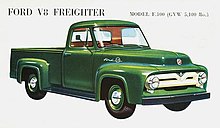
Ford also manufactures F-Series medium and heavy-duty pick-ups alongside the F-150, F-250, and F-350s (F-450, F-550, F-650, F-750 Super Duty trucks). Prior to 1998 in the United States, there were a number of variants sold alongside the F-Series.
- B-Series (1948-1998) - school bus chassis based on medium-duty F-Series
- Econoline/E-Series (1975-2014) - mechanically related to F-Series
- P-Series - parcel delivery van chassis
- An F-8000 was also produced based on the Ford Cargo cab-over range, which was similar to the 2006 and newer Ford LCF ("Low Cab Forward").
While previously a unique platform, after their 1975 redesign, the Econoline/E-Series vans have maintained strong similarity with the F-Series pickup trucks, although it is now only mechanically true, as the latter has now undergone a number of redesigns since the last update of the vans in 1992.
Medium-duty variants of the F-Series have their own chassis, sharing only the cab with lower-GVWR models. The current generation of F-650/F-750 Super Duty models combine the Ford Super Duty cab with a chassis shared with the International DuraStar line of trucks.
Right-hand drive versions of the F-Series (for the United Kingdom and Australia) are manufactured in Brazil.
In Argentina and Brazil, the petrol engines are often converted to also run with alternative fuels, E-96h (Brazilian-spec ethanol) and Liquid Petroleum Gas (LPG). Biodiesel also is used in diesel engines.
See also
- Ford Super Duty
- Ford F-650
- Sterling Trucks Bullet pickup
References
- ^ "Auto sales reach six-year high of 15.6 million vehicles sold, Ford F-Series takes the lead". NY Daily News. 2014-01-06.
- ^ Ford Motor Company (2007-05-25). "Ford's Best Selling Pickups Add More Features For 2008". Truck Trend. Auto News.
- ^ Cato, Jeremy (2010-03-25). "Top 10 best-selling vehicles - The Globe and Mail". The Globe and Mail. Toronto.
- ^ Magda, Mike (2006-02-05). "Interview with GMC Sierra Brand Manager Lorraine Babiar". Pickuptruck.com.
- ^ Dale, Wickell. About.com http://trucks.about.com/od/fseriespasttopresent/tp/ford-trucks.htm.
{{cite web}}: Missing or empty|title=(help) - ^ Cluczyk, Barry (December 2012), "Ford F-150 - Boosting The EcoBoost", Truckin Magazine
{{citation}}:|access-date=requires|url=(help) - ^ "New 2010 Ford Harley-Davidson F-150: tough truck with cool attitude; new details, inside and out". Media.ford.com. February 10, 2009. Retrieved 2009-04-28.
- ^ "RIP: Lincoln Mark LT". September 2007. Retrieved 2007-09-04.
- ^ "Ford SVT F-150 Raptor R to enter Baja 1000". Fordnewsblog.wordpress.com. 2008-11-26. Retrieved 2010-10-19.
- ^ Phillips, Drew (2008-11-25). "Ford F-150 SVT Raptor R completes inaugural run of Baja 1000". Autoblog.com. Retrieved 2010-10-19.
- ^ 2008 Baja 1000 class results[dead link]
- ^ "2010 FORD F150 SVT RAPTOR R CAPTURES PODIUM FINISH; PRICING ANNOUNCED". Ford-trucks.com. Retrieved 2010-10-19.
- ^ "2009 FORD F-150 AWARDS". Media.ford.com. 2008-12-16. Retrieved 2010-10-19.
- ^ http://media.ford.com/article_print.cfm?article_id=872
- ^ "Ford Motor Company Sets New Full Year U.S. Sales Record". Theautochannel.com. Retrieved 2009-04-28.
- ^ "Ford Motor Company's December U.S. Sales Climb 8.2 Percent" (PDF). Ford Motor Company.
- ^ "Ford's F-Series Truck Caps 22nd Year in a Row as America's Best-Selling Vehicle With a December Sales Record". Theautochannel.com. 2004-11-17. Retrieved 2009-04-28.
- ^ "Ford Achieves First Car Sales Increase Since 1999". Theautochannel.com. 2004-11-17. Retrieved 2009-04-28.
- ^ "Ford Motor Company 2007 sales". January 3, 2008.
- ^ "F-Series drives ford to higher market share for third consecutive month" (PDF). Ford Motor Company. January 5, 2009. Retrieved 2009-05-14.
- ^ "FORD CAPS 2009 WITH 33 PERCENT SALES INCREASE, FIRST FULL-YEAR MARKET SHARE GAIN SINCE 1995" (PDF). Ford Motor Company. January 5, 2010. Retrieved 2010-01-05.
- ^ "Ford's 2010 Sales Up 19 Percent - Largest Increase of Any Full-Line... - DEARBORN, Mich., Jan. 4, 2011 /PRNewswire/". Michigan: Prnewswire.com. Retrieved 2011-10-23.
- ^ "STRONG CAR SALES DRIVE FORD TO #1 IN CANADA | Ford Motor Company Newsroom". Media.ford.com. 2011-01-04. Retrieved 2011-10-23.
- ^ "Ford is top-selling automaker in Canada for three consecutive years" (Press release). Ford. 2013-01-03. Retrieved 2013-01-04.
- ^ http://media.ford.com/content/dam/fordmedia/North%20America/US/2014/01/december13sales.pdf
External links
- Ford vehicles
- Pickup trucks
- Rear-wheel-drive vehicles
- All-wheel-drive vehicles
- 1940s automobiles
- 1950s automobiles
- 1960s automobiles
- 1970s automobiles
- 1980s automobiles
- 1990s automobiles
- 2000s automobiles
- 2010s automobiles
- Vehicles introduced in 1948
- Flexible-fuel vehicles
- Motor vehicles manufactured in the United States
